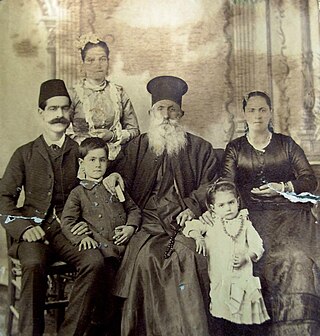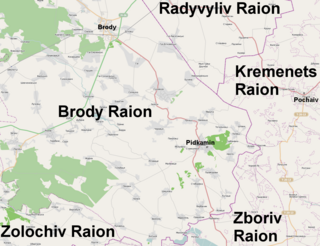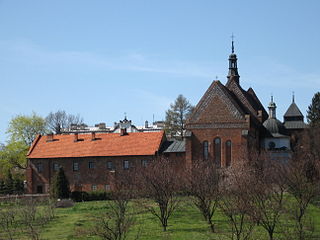
The Tridentine Mass, also known as the Traditional Latin Mass or the Traditional Rite, is the liturgy in the Roman Missal of the Catholic Church published from 1570 to 1962. Celebrated almost exclusively in Ecclesiastical Latin, it was the most widely used Eucharistic liturgy in the world from its issuance in 1570 until the introduction of the Mass of Paul VI.
Subdeacon is a minor order or ministry for men in various branches of Christianity. The subdeacon has a specific liturgical role and is placed between the acolyte and the deacon in the order of precedence.
Clerical celibacy is the requirement in certain religions that some or all members of the clergy be unmarried. Clerical celibacy also requires abstention from deliberately indulging in sexual thoughts and behavior outside of marriage, because these impulses are regarded as sinful.

Sandomierz is a historic town in south-eastern Poland with 23,863 inhabitants, situated on the Vistula River in the Sandomierz Basin. It has been part of Świętokrzyskie Voivodeship since 1999, having previously been located in the Tarnobrzeg Voivodeship. It is the capital of Sandomierz County. Sandomierz is known for its preserved Old Town, a major cultural and tourist attraction which was declared a National Monument of Poland in 2017.

Clerical marriage is the practice of allowing Christian clergy to marry. This practice is distinct from allowing married persons to become clergy. Clerical marriage is admitted among Protestants, including both Anglicans and Lutherans. Some Protestant clergy and their children have played an essential role in literature, philosophy, science, and education in Early Modern Europe.
George Nichols was an English Catholic martyr.

Solemn Mass is the full ceremonial form of a Mass, predominantly associated with the Tridentine Mass where it is celebrated by a priest with a deacon and a subdeacon, requiring most of the parts of the Mass to be sung, and the use of incense. It is also called High Mass or Solemn High Mass.
The Dryburne Martyrs: Richard Hill, Richard Holiday, John Hogg and Edmund Duke were English Roman Catholic priests and martyrs, executed at Dryburne, County Durham, in the reign of Elizabeth I. They were beatified by Pope John Paul II in 1987.
John Shert was an English Catholic priest and martyr, who was executed during the reign of Elizabeth I.
Ecclesiastical titles are the formal styles of address used for members of the clergy.

The Order of Saint Basil the Great, also known as the Basilian Order of Saint Josaphat, is a Greek Catholic monastic order of pontifical right that works actively among Ukrainian Catholics and other Greek-Catholic churches in central and Eastern Europe. The order received approbation on August 20, 1631, and is based at the Monastery of the Holy Trinity, Vilnius.

Pidkamin is an urban-type settlement in Zolochiv Raion, Lviv Oblast, western Ukraine. It is located near the administrative border of three oblasts, Lviv, Rivne, and Ternopil. Pidkamin hosts the administration of Pidkamin settlement hromada, one of the hromadas of Ukraine. Population: 1,895.

The Lesser Poland Way is one of the Polish routes of the Way of St. James, a medieval pilgrimage route to Santiago de Compostela in Spain. It runs from Sandomierz to Kraków through the Lesser Poland Voivodeship and the Świętokrzyskie Voivodship. It is an alternative path of the main Via Regia that in the Middle Ages ran from Estonia through Vilnius, Grodno and Lublin. The Lesser Poland Way was partially reopened on 25 October 2008. The whole route was reopened on 25 October 2009. another feeder route ran from Tarnobrzeg.

The Church of St. James in Sandomierz, also known as the Shrine of Blessed Sadok and 48 Dominican martyrs, Monastery of Dominicans, Shrine of Our Lady of the Rosary, is one of the oldest brick churches in Poland and the second oldest Dominican monastery in Poland. This church is a unique indirect form of Romano-Gothic style. The Roman ceramic decorations on the outside gabled walls are unusual and beautifully done. The stained glass windows inside are particularly beautiful, and date from 1910 to 1918.

Józef Cebula was a Polish priest of the Missionary Oblates of Mary Immaculate (OMI).

The second Mongol invasion of Poland was carried out by General Boroldai (Burundai) of the Golden Horde in 1259–1260. During this invasion the cities of Sandomierz, Kraków, Lublin, Zawichost, and Bytom were sacked by the Mongols for the second time.
The siege and second sack of Sandomierz took place in 1259-1260 during the second Mongol invasion of Poland. The city was razed and residents massacred.

Bedřich Bachstein and his thirteen companions were a collective group of Roman Catholic priests and professed religious in the Order of Friars Minor. Four were Czech while there was one Spaniard, one Frenchman, four Italians, three Germans, and one Dutchman. Three were clerics in the order while another three were novices since the rest were all ordained priests. The Franciscans settled in Prague in 1604 and set out to administer the sacraments as well as to tend to the ill and the poor. The friars became known for their preaching despite the consistent threats levelled against them from those in non-Catholic denominations. The fourteen were slain in Prague after Emperor Rudolf II invaded Prague; the fourteen were surprised at the sudden attack on their convent at the Church of Our Lady of the Snows and were all slain at the hands of a Lutheran mob.











